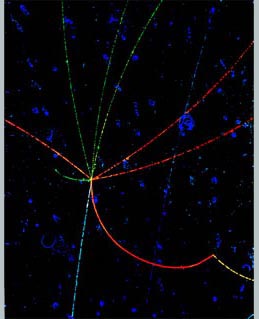 |
||
|
|
 |
|
|
Antimatter exists for every kind of matter particle. Berkeley was the first place to artificially create the antimatter version of proton (the antiproton) for which Emilio Gino Segré and Owen Chamberlain were awarded the Nobel prize. In this picture, the created antiproton enters the bubble chamber and meets a proton inside the chamber. When they meet, they annihilate and turn into pure energy. The energy then turns into other forms of matter in a "star"-like spectacle. These days we can create bits of antimatter routinely using particle accelerators. And you should handle them carefully. In Angels and Demons by Dan Brown, a ill-willed person threatens to blow up the Vatican with antimatter. The antimatter is suspended in the air using a battery-powered device. But the battery will run out of juice eventually, and the antimatter will drop to the floor (which happens to be made of matter). When matter and antimatter meet, they annihilate, and a quarter gram of antimatter would equal the energy of the Hiroshima-scale atomic bomb.
When the universe started with the Big Bang, there was so much energy that a huge amount of antimatter was created together with matter. As the universe expanded and cooled, matter encountered antimatter and they annihilated. Fortunately, annilation was not total - we (matter) outnumbered antimatter by a tiny bit. We won, but this tiny imbalance is still a big mystery. This leads to the ultimate question, "Why do we exist?" Even the existence of ordinary matter is not taken for granted by BCCP scientists.
Matter / Antimatter Score:
It is clear that the kind of subtle difference between quarks and anti-quarks observed to date (most spectacularly at SLAC/LBNL B-factory) is not enough to explain this excess. There is a popular idea that neutrinos have turned a billionth of antimatter into matter. BCCP cosmologists Hitoshi Murayama and Lawrence Hall are building models of excess matter.
Hitoshi Murayama is also director of the Institute for the Physics and Mathematics of the Universe (IPMU) at the University of Tokyo - the first of a planned 30 research centers for the World Premier International Research Center Initiative (WPI).
|




